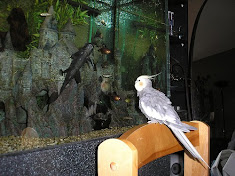Purple firefish are often mistaken for gobies. While they are very closely related to the goby family, they are actually dartfish. This species is predominantly white or yellow with slender cylindrical bodies. The body markings on this fish are extraordinary. They have a purple patch on their head and their fins are trimmed with varying shades of purple, blue, red, orange and maroon. This is a small fish. It will only grow to a maximum length of 4 inches. They are more typically 2.5-3 inches.
 |
| Purple Firefish by Jamie Henderson |
This fish carries an easy care rating and is an excellent choice for the inexperienced saltwater aquarium owner. They are rated reef safe. This is a hardy, very disease resistant species. Their general durability, small size and tolerance of varied water parameters make them extremely popular among nano-reef owners. This fish can be kept in an aquarium as small as 10 gallons, even smaller if you are diligent in maintaining water quality. Purple firefish are also sold by the aquarium industry under the names elegant firefish, flame firefish, decorated firefish, fire goby, and purple dartfish.
If this fish's size and survivability tempt you to add one to your community tank you should be aware that they are prolific jumpers. They should only be kept in a tightly lidded aquarium. This is one of the more aggressive dartfish but is still relatively docile compared to other marine species. It should only be kept with smaller, less aggressive fish. They will exhibit territorial behavior toward their own kind. Do not purchase multiples. A male and female of the species will mix together well.
The purple firefish will require lots of hiding places. Plenty of coral rubble on top of your primary substrate will make them feel right at home. This fish must be allowed to feel confident in its new surroundings. It will starve itself to death rather than compete for its food. A fading in color is a good indication that it is suffering from malnutrition. If food is not an issue this fish may live from 7-10 years in captivity.
This is a carnivorous species. In their natural habitat its diet consists primarily of zooplankton. In captivity they will eat flaked food and pellets. However as with any marine species it is advisable to provide these fish with a varied diet. You can feed them vitamin enriched brine shrimp, mysid shrimp, finely chopped fresh seafood and frozen or freeze dried food formulated for marine carnivores. These supplements will help maintain their fit and vigor.
Purple firefish do occasionally breed in home aquariums. This is an egg laying species. They are also monogamous in nature. Once a pair is mated they may spawn 2-4 times a month. Eggs are whitish in coloration and approximately 2mm in diameter. The egg's incubation period is 7-10 days depending on water temperature.
An aquarium doesn't have to be the same mundane rectangular tank found in everyone else's home. Why settle for the ordinary? Your aquarium should be a focal point to your décor, not just an afterthought shoved away in some corner. We offer unique alternatives to the traditional rectangle fish tank. Transform your fish's home into a piece of living art. Get the Look of a Custom Aquarium Without the Custom Price Tag at Exotic-Aquariums.com: Your Freshwater & Saltwater Aquarium Source.
Author Resource: Written by Stephen J. Broy
Helping you have healthier and happier fish is an essential part of our business. If you found this article interesting and would like to learn more about your favorite freshwater & saltwater aquarium fish visit our Online Fish Buying Guide.
Article Source: http://EzineArticles.com/?expert=Stephen_J_Broy
http://EzineArticles.com/?Tips-on-Purple-Firefish-Care&id=3316517



0 comments:
Post a Comment